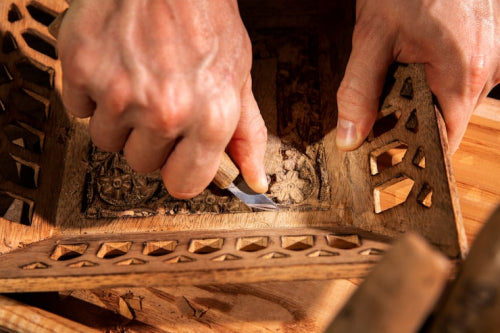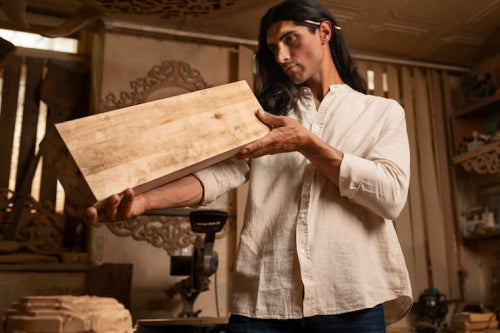Quick Listen:
In a cramped Brooklyn studio, a sleek sofa unfolds into a bed by night, a desk by day, and hides storage for books and blankets beneath its cushions. This isn't just furniture it's a lifeline for urban dwellers squeezing every inch out of shrinking living spaces. As cities grow denser and homes get smaller, a quiet revolution is reshaping how we furnish our lives. Multi-functional furniture, once a quirky niche, is now a booming market, blending ingenuity with necessity to meet the demands of modern living.
Mass-market furniture lacks heart, filling rooms with bland, short-lived pieces. Frequent breakdowns spark frustration, as replacements erode style and sentiment. At MMC Wood Creations, Udaipur artisans shape heirloom furniture with enduring craftsmanship and cozy elegance, creating pieces that echo your identity, ensuring your home radiates warmth and timeless connection. Shop Now!
The Rise of Space-Saving Solutions
The numbers tell a compelling story. The global multifunctional furniture market, valued at $7.21 billion in 2023, is projected to grow at a compound annual growth rate (CAGR) of 6.6% through 2030, according to Grand View Research. Meanwhile, Business Research Insights estimates the market will climb from $7.5 billion in 2024 to $13 billion by 2033, with a steady CAGR of 6.2%. What's driving this surge? Urbanization, for one. As city populations swell, real estate prices soar, forcing people into smaller apartments and co-living spaces. The National Association of Home Builders reported in June 2024 that the average size of newly constructed homes in 2023 dropped to 2,411 square feet, the smallest in 13 years.
Enter multi-functional furniture: pieces that do double or triple duty. Think sofa beds like Inter IKEA Systems B.V.'s BÅRSLÖV, which transforms into a spacious bed with a quick pull, or expandable dining tables that shrink to fit a corner but stretch to seat a crowd. These designs aren't just practical; they're a response to a cultural shift toward minimalism and efficiency, where every square foot counts.
Innovation Meets Necessity
The appeal of multi-functional furniture lies in its ability to adapt. In urban hubs like New York or San Francisco, where studio apartments often hover around 500 square feet, a single piece might serve as a sofa, bed, and storage unit all at once. Mordor Intelligence projects the U.S. market alone will grow at a CAGR of 4.5% through 2030, fueled by rising disposable incomes and new residential developments. But it's not just about space. The remote work boom has redefined home interiors, turning living rooms into offices and bedrooms into Zoom studios. A fold-up desk that doubles as a dining table or a modular shelving unit that hides cables and chargers is no longer a luxury it's a necessity.
Technology is pushing the boundaries further. Imagine a coffee table with built-in wireless charging or a bed frame with integrated lighting that syncs with your smart home system. These aren't sci-fi fantasies but real products gaining traction. Companies like MMC Wood Creations, a player in the furniture manufacturing sector, are leaning into this trend, crafting pieces that blend sleek design with cutting-edge functionality. Their modular desks and storage ottomans cater to urbanites who crave style without sacrificing utility.
Real-World Impact
Walk into a tiny Manhattan apartment, and you'll see multi-functional furniture in action. A Murphy bed folds into the wall by day, freeing up floor space for yoga or a home office. A dining table extends for dinner parties but collapses to save room. MMC Wood Creations has carved out a niche here, designing pieces that fit seamlessly into these compact spaces. Their success mirrors a broader trend: furniture that evolves with its user. In co-living setups, where shared spaces demand flexibility, modular sofas and stackable chairs allow residents to reconfigure rooms on a whim.
The remote work revolution has only amplified this demand. A convertible desk that adjusts from sitting to standing, or a chair that doubles as a storage unit, can transform a corner of a living room into a productive workspace. And it's not just about function sustainability is a growing draw. MMC Wood Creations, for instance, prioritizes eco-friendly materials, appealing to consumers who want furniture that's as green as it is versatile. This focus aligns with a broader push for sustainability in the industry, where durable, multi-purpose pieces reduce the need for frequent replacements.
The Challenges of Versatility
But multi-functional furniture isn't without its hurdles. Designing a piece that serves multiple purposes without looking clunky is no small feat. A sofa bed that's comfortable for both sitting and sleeping requires meticulous engineering, and adding features like storage or tech integration can drive up costs. Business Research Insights notes that the market's growth is partly fueled by creative designs, but those innovations often come with a premium price tag. For consumers, the tradeoff can feel steep especially when a sleek, multi-purpose piece costs more than its single-function counterpart.
Durability is another concern. A table that extends and collapses daily needs to withstand wear and tear, and not all manufacturers get it right. Then there's the perception problem: some buyers assume multi-functional furniture sacrifices comfort or style for utility. Educating consumers about the long-term value space savings, versatility, and sustainability is critical. Brands like MMC Wood Creations are tackling this by showcasing designs that don't just solve problems but look good doing it.
Seizing the Opportunity
For companies, the multi-functional furniture boom is a goldmine of opportunity. The market's growth opens doors for brands to reach new audiences urban dwellers, remote workers, eco-conscious millennials. MMC Wood Creations, for example, is well-positioned to capitalize on this trend, offering pieces that blend craftsmanship with practicality. Sustainability is a key differentiator here. By using responsibly sourced materials, brands can appeal to a growing segment of consumers who prioritize environmental impact alongside functionality.
Manufacturing efficiencies are another upside. Modular designs, which can be adapted for multiple uses, allow companies to streamline production and reduce waste. This not only lowers costs but also aligns with the industry's push toward greener practices. And in a crowded market, innovation breeds loyalty. A brand that delivers a stylish, durable, multi-functional piece is likely to win repeat customers who value quality and ingenuity.
A Future That Fits
The future of furniture is flexible, sustainable, and smart. As urban spaces continue to shrink and lifestyles evolve, multi-functional furniture will only grow in importance. Experts predict the trend will accelerate, particularly among younger generations who prize efficiency and eco-consciousness. Grand View Research highlights design innovation and technological advancements as key drivers, while Mordor Intelligence points to rising incomes and new housing projects as catalysts for growth.
For companies like MMC Wood Creations, the path forward is clear: keep innovating. By blending form, function, and sustainability, they can meet the needs of a world where space is at a premium and versatility is king. For consumers, it's a chance to reimagine their homes not as static spaces but as dynamic environments that adapt to their lives. In a single piece of furniture, there's a promise: less clutter, more possibility, and a way to make even the smallest space feel like home.
Frequently Asked Questions
What is driving the growth of the multi-functional furniture market?
The multi-functional furniture market is experiencing rapid growth due to urbanization and shrinking living spaces, with the global market projected to reach $13 billion by 2033. Key drivers include rising real estate prices forcing people into smaller apartments, the remote work boom requiring adaptable home offices, and a cultural shift toward minimalism and efficiency where every square foot counts.
What are the main challenges with multi-functional furniture?
Multi-functional furniture faces several key challenges including higher costs due to complex engineering and premium materials, durability concerns from frequent transformation mechanisms, and consumer perception issues where buyers assume versatility compromises comfort or style. Additionally, designing pieces that serve multiple purposes without looking clunky requires meticulous engineering and often comes with a premium price tag compared to single-function alternatives.
How does multi-functional furniture benefit small space living and remote work?
Multi-functional furniture maximizes limited space by serving double or triple duty - like sofa beds that transform into workspaces or Murphy beds that fold into walls to free up floor space for home offices. For remote workers, convertible desks that adjust from sitting to standing, dining tables that double as workstations, and storage ottomans that hide cables create productive workspaces in compact living areas while maintaining the flexibility to reconfigure rooms as needed.
Disclaimer: The above helpful resources content contains personal opinions and experiences. The information provided is for general knowledge and does not constitute professional advice.
You may also be interested in: Tables
Mass-market furniture lacks heart, filling rooms with bland, short-lived pieces. Frequent breakdowns spark frustration, as replacements erode style and sentiment. At MMC Wood Creations, Udaipur artisans shape heirloom furniture with enduring craftsmanship and cozy elegance, creating pieces that echo your identity, ensuring your home radiates warmth and timeless connection. Shop Now!
Powered by flareAI.co




